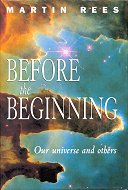
This slim readable book overviews our current understanding of cosmology -- the structure and history of the entire universe -- by focussing on six key physical parameters. These are: the strength of gravity relative to electrical force; the efficiency of nuclear fusion; the curvature (or as it turns out, flatness) of the universe, Omega; the cosmological expansion constant, lambda; the smoothness of the initial matter distribution; and the number of spatial dimensions. The values of these numbers determine critical features of the universe, such as its size, how much time is available for galaxy formation, and how the stars shine. And what is quite fascinating is that if these values were different, sometimes by amazing small amounts, the resulting universe would be entirely different, so much so that life as we know it could not exist.
I would have preferred a bit more technical meat (such as provided in Lee Smolin's The Life of the Cosmos, which covers some of the same material, especially the fine-tuning of the values, but in more depth in places), and a bibliography. But what is here is very readable, and weaves together a fascinating tale of the universe, and how our understanding of it has advanced enormously in just a handful of decades.